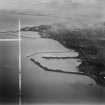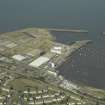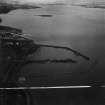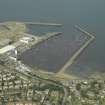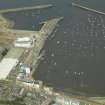Edinburgh, Granton Harbour, Western Breakwater And Esparto Wharf
Breakwater (19th Century)
Site Name Edinburgh, Granton Harbour, Western Breakwater And Esparto Wharf
Classification Breakwater (19th Century)
Alternative Name(s) Esparto Wharf; Granton Quarry; Granton Oil Refinery
Canmore ID 52053
Site Number NT27NW 28.02
NGR NT 23371 77802
NGR Description NT 23821177863 to NT 23155 77493
Datum OSGB36 - NGR
Permalink http://canmore.org.uk/site/52053
- Council Edinburgh, City Of
- Parish Edinburgh (Edinburgh, City Of)
- Former Region Lothian
- Former District City Of Edinburgh
- Former County Midlothian
NT27NW 28.02 2382 7787 to 2312 7742
For lighthouse (beacon) at NT 2381 7788, see NT27NW 28.05.
Western Breakwater [NAT] (at NT 2340 7783)
Esparto Wharf [NAT] (at NT 2358 7780)
OS 1:10,000 map, 1987.
Granton Harbour is still in use and is well maintained. The south side of the western Harbour appears to be reclaimed by dumping waste material. There appears to be some recent dumping and erosion of this area.
Site recorded by GUARD during the Coastal Assessment Survey for Historic Scotland, 'The Firth of Forth from Dunbar to the Coast of Fife' 26th February 1996.
An archaeological watching brief was carried out in this area ahead of a proposed housing development on reclaimed land between the western Breakwater and Middle Pier. At Western Breakwater a 15m length of ashlar wall was uncovered in reclaimed ground to the E of the Breakwater, running at right angles to the main structure of the pier. The ashlar blocks used in its construction measured 1.5m x 0.9m x 0.6m and just over two courses were uncovered. On the southern side of the wall, running at right angles to it, the remains of three lines of wooden piles were visible. An ashlar projection, 15m x 9m and strengthened by a latticework of metal rods, was found and is thought to be a plinth for a steam crane, which is shown on the 1st edition OS map. Later maps show a 25-ton coal crane in this location.
Two ashlar plinths were uncovered in reclaimed ground to the E of Western Breakwater. They measured 7.3m x 5.75m and 7.3m x 5.95m and were constructed in ashlar masonry. This appears to be the location of another steam crane, as depicted on the 1st edition OS map.
A 22m length of the upper edge of the Western Breakwater was exposed in order to locate a valve outlet chamber. The section of breakwater exposed was found to measure around 12m wide, with a short section 15m wide. The wider section was ocnstructed in large ashlar blocks, up to 2m x 1m, while the narrower 12m wide section of breakwater was lined with timbers. The wider, ashlar section appears to have been the location of an engine house, again depicted on the 1st edition OS map. The breakwater was constructed of ashlar blocks, with the top being of stone, rounded at the edge, and overhanging the ashlar sides by 0.35m. The stone was capped by pitch pine beams, held in position with metal spikes.
A series of 9 test pits were excavated against the edge of the harbour wall at 100m intervals along the length of the Western Breakwater. These uncovered a hollow area between the main harbour wall and an ashlar wall in the centre of the pier. This void had been back-filled using rubble and hardcore, which was then tarred over to create the current road surface. The distance between the main harbour wall and the ashlar wall was nearly 3m and just over 2m in maximum depth. The sections of harbour wall uncovered had been formed from cast concrete, with the pour lines clearly visible at 0.25m intervals.
M Kirby 2005
A large dump of timber piles, from the remains of the timber wharf built against the western breakwater in 1863, were subjected to a photographic survey by CFA Archaeology Ltd. Carpentry joints, iron fittings and carved numerical coding used during the wharf's construction were noted and recorded.
M Cressey 2005
NT 234590 779807 A watching brief and subsequent photographic survey of timber piles were carried out between June 2004 and June 2005 during redevelopment for housing on an area of reclaimed land located between the Western Breakwater (NT27NW 28.02) and Middle Pier (DES 2004, 55).
A large number of timber piles associated with the former Esparto grass wharf were removed and stored on site. The piles were photographed in detail and all significant fixtures and fittings were recorded. The majority of the piles appear to be recent, and are probably associated with renovation work carried out in 1937.
Occasional fragments of timber appear to be earlier and are likely to be from the original 1863 structure. Some of the piles were found to contain wrought iron nails, and are likely to have been the timbers that supported the wharf deck.
Interim reports lodged with Edinburgh SMR.
Sponsor: Forth Property Developments Ltd.
M Cressey 2005
Standing Building Recording (May 2008 - November 2008)
NT 2337 7780 A watching brief and standing building survey were conducted between May–November 2008 prior to and during construction works on the western breakwater. Ground-breaking during the strengthening of the current sea wall exposed the remains of the original harbour wall and stone pitching. The construction techniques used to build the wall and a sequence of alterations were identified and recorded. The original 19th-century breakwater wall, of sandstone ashlar construction, was recorded in all trenches. A foundation course of bevelled blocks had formed the toe of the breakwater.
The building survey consisted of a detailed appraisal of the surviving ashlar wall at the tip of the western breakwater. The wall, which was recorded for a length of c150m, was found to have a number of scars and features on its internal harbour-facing elevation. These included fittings for lamp stands and brackets for electric cables. The remains of a stone and brickwork structure (probably a building) were recorded at the very tip of the breakwater.
Archive: City of Edinburgh Council Archaeology Service (CECAS) SMR and RCAHMS
Funder: Forth Property Developments Ltd
Phil Moore and Philip Richardson – CFA Archaeology Ltd
Excavation (24 October 2023)
NT 23272 77673 AOC was commissioned by Reiach & Hall Architects to undertake an archaeological works at Plot 26 Granton Harbour, Edinburgh. The works were a prerequisite in relation to a planning condition for the redevelopment of the site.
The archaeological works were intended to locate the 19th century harbour wharf as this may have been within the footprint of one of the residential units (Block A). A total of four trenches were opened with the harbour wharf likely encountered within Trench 2 at a depth of over 2.5 m. In Trench 4 a large concrete base at a depth of 1.9 m may also be associated with the wharf. In Trench 1 a large concrete slab encountered at a depth of 0.6 m is thought to be much more modern in date. Across the investigation area the upper deposits was a mix of building crush and rubble with brick, concrete, metal and sandstone noted. In Trench 1 and 2 large potentially in situ wooden timbers were uncovered.
The position of the harbour wharf appears to lie outside the limits of the proposed Block A footprint. The proposed small substation building in the location of Tr.2 appears to overlap with the wharf remains. However, these remains in Tr.2 were at considerable depth at c 2.5 m below current ground levels and the proposed substation buildings are extremely shallow and will not impact on the wharf remains which would effectively remain in situ beneath the new build substation.
Infromation from AOC Archaeology Group.












